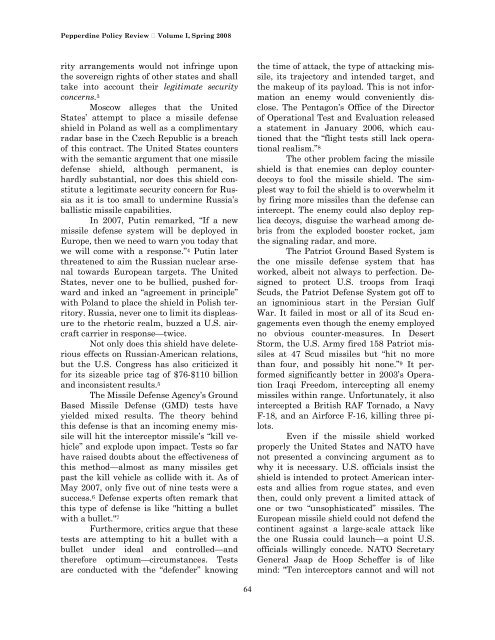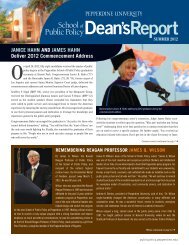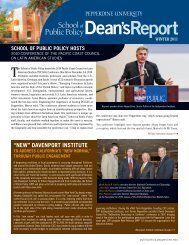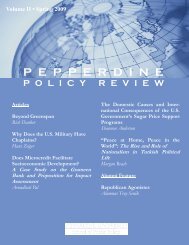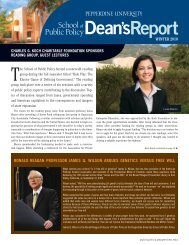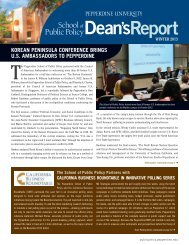Pepperdine University School of Public Policy
Pepperdine University School of Public Policy
Pepperdine University School of Public Policy
Create successful ePaper yourself
Turn your PDF publications into a flip-book with our unique Google optimized e-Paper software.
<strong>Pepperdine</strong> <strong>Policy</strong> Review Volume I, Spring 2008<br />
rity arrangements would not infringe upon<br />
the sovereign rights <strong>of</strong> other states and shall<br />
take into account their legitimate security<br />
concerns. 3<br />
Moscow alleges that the United<br />
States’ attempt to place a missile defense<br />
shield in Poland as well as a complimentary<br />
radar base in the Czech Republic is a breach<br />
<strong>of</strong> this contract. The United States counters<br />
with the semantic argument that one missile<br />
defense shield, although permanent, is<br />
hardly substantial, nor does this shield constitute<br />
a legitimate security concern for Russia<br />
as it is too small to undermine Russia’s<br />
ballistic missile capabilities.<br />
In 2007, Putin remarked, “If a new<br />
missile defense system will be deployed in<br />
Europe, then we need to warn you today that<br />
we will come with a response.” 4 Putin later<br />
threatened to aim the Russian nuclear arsenal<br />
towards European targets. The United<br />
States, never one to be bullied, pushed forward<br />
and inked an “agreement in principle”<br />
with Poland to place the shield in Polish territory.<br />
Russia, never one to limit its displeasure<br />
to the rhetoric realm, buzzed a U.S. aircraft<br />
carrier in response—twice.<br />
Not only does this shield have deleterious<br />
effects on Russian-American relations,<br />
but the U.S. Congress has also criticized it<br />
for its sizeable price tag <strong>of</strong> $76-$110 billion<br />
and inconsistent results. 5<br />
The Missile Defense Agency’s Ground<br />
Based Missile Defense (GMD) tests have<br />
yielded mixed results. The theory behind<br />
this defense is that an incoming enemy missile<br />
will hit the interceptor missile’s “kill vehicle”<br />
and explode upon impact. Tests so far<br />
have raised doubts about the effectiveness <strong>of</strong><br />
this method—almost as many missiles get<br />
past the kill vehicle as collide with it. As <strong>of</strong><br />
May 2007, only five out <strong>of</strong> nine tests were a<br />
success. 6 Defense experts <strong>of</strong>ten remark that<br />
this type <strong>of</strong> defense is like "hitting a bullet<br />
with a bullet." 7<br />
Furthermore, critics argue that these<br />
tests are attempting to hit a bullet with a<br />
bullet under ideal and controlled—and<br />
therefore optimum—circumstances. Tests<br />
are conducted with the “defender” knowing<br />
the time <strong>of</strong> attack, the type <strong>of</strong> attacking missile,<br />
its trajectory and intended target, and<br />
the makeup <strong>of</strong> its payload. This is not information<br />
an enemy would conveniently disclose.<br />
The Pentagon’s Office <strong>of</strong> the Director<br />
<strong>of</strong> Operational Test and Evaluation released<br />
a statement in January 2006, which cautioned<br />
that the “flight tests still lack operational<br />
realism.” 8<br />
The other problem facing the missile<br />
shield is that enemies can deploy counterdecoys<br />
to fool the missile shield. The simplest<br />
way to foil the shield is to overwhelm it<br />
by firing more missiles than the defense can<br />
intercept. The enemy could also deploy replica<br />
decoys, disguise the warhead among debris<br />
from the exploded booster rocket, jam<br />
the signaling radar, and more.<br />
The Patriot Ground Based System is<br />
the one missile defense system that has<br />
worked, albeit not always to perfection. Designed<br />
to protect U.S. troops from Iraqi<br />
Scuds, the Patriot Defense System got <strong>of</strong>f to<br />
an ignominious start in the Persian Gulf<br />
War. It failed in most or all <strong>of</strong> its Scud engagements<br />
even though the enemy employed<br />
no obvious counter-measures. In Desert<br />
Storm, the U.S. Army fired 158 Patriot missiles<br />
at 47 Scud missiles but “hit no more<br />
than four, and possibly hit none.” 9 It performed<br />
significantly better in 2003’s Operation<br />
Iraqi Freedom, intercepting all enemy<br />
missiles within range. Unfortunately, it also<br />
intercepted a British RAF Tornado, a Navy<br />
F-18, and an Airforce F-16, killing three pilots.<br />
Even if the missile shield worked<br />
properly the United States and NATO have<br />
not presented a convincing argument as to<br />
why it is necessary. U.S. <strong>of</strong>ficials insist the<br />
shield is intended to protect American interests<br />
and allies from rogue states, and even<br />
then, could only prevent a limited attack <strong>of</strong><br />
one or two “unsophisticated” missiles. The<br />
European missile shield could not defend the<br />
continent against a large-scale attack like<br />
the one Russia could launch—a point U.S.<br />
<strong>of</strong>ficials willingly concede. NATO Secretary<br />
General Jaap de Hoop Scheffer is <strong>of</strong> like<br />
mind: "Ten interceptors cannot and will not<br />
64


